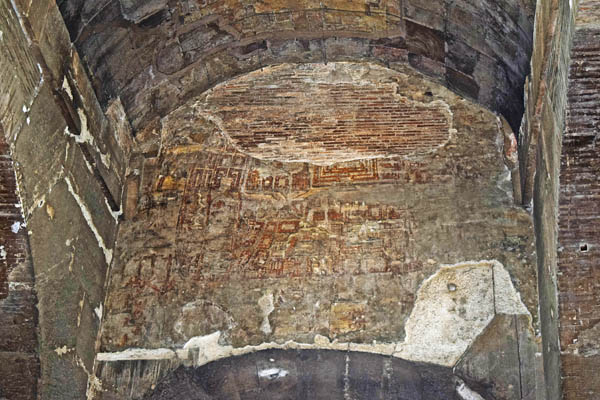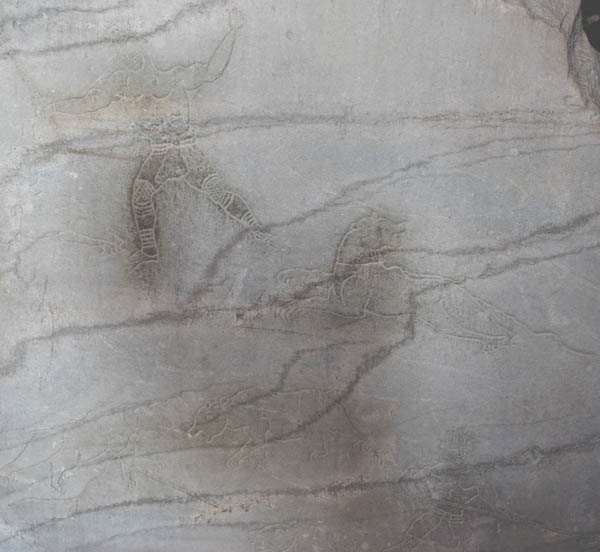Jerusalem in Rome – Searching for the Dedicatory Inscription in the Colosseum
Last week, on a visit to Rome, we went in search of the Dedicatory Inscription in the Colosseum that I had blogged about in 2008. Walking down the Via dei Fori Imperiali, the wide avenue built by Mussolini flanking the Forum and leading to the amphitheatre was a pleasure, as the Colosseum is no longer a crazy traffic circle. Cars are banned, with buses and taxis still allowed, but with strict speed restrictions. The scene that greets you at the piazza surrounding the Colosseum still resembles a funfair, with costumed “centurions” (some smoking cigarettes) and demanding exhorbitant prices from visitors to have their photo taken with them, hawkers selling everything from souvenirs to selfie sticks and horses waiting patiently beside their carriage for their next passengers. Meanwhile scaffolding snakes its way around the Colosseum in a $35 million renovation project due to be completed in 2016.
From what we had read in an excellent article on the inscription by Prof. Louis Feldman in BAR (July/August 2001), we expected to find it lying on the ground on the right-hand side of the main entrance passageway. We described the inscription to a guard and were directed to the medieval painting of Jerusalem high up in one of the arches. This is based on a well-known depiction of the city by the Dutch theologian Christiaan van Adrichem.

After a fruitless search around the corridors, we tried asking at the office of the archaeological superintendent of the site, where the lady at the desk said that she didn’t have a clue as to the whereabouts of the inscription. Put on to the phone to her boss, we were told that she thought it was on the second level. Climbing the steep travertine steps, we had views over the interior of the amphitheatre, including the dark corridors of the hypogeum or underground area, from where caged animals and gladiators would be brought up for the entertainment of the Romans from every social class.
Approaching the area of the lift, one of the innovations designed to bring visitor facilities into the twenty-first century, but which was very difficult to find on the ground floor where it was needed, we saw two large groups of visitors who looked spellbound. One of the groups was gathered round an exhibit showing recently discovered graffiti depicting a gladiator fight. Other graffiti showed gladiators fighting wild beasts.

An even larger crowd was gathered round two astonishingly vivid reconstruction drawings that depicted spectators sitting in the amphitheatre.

The top drawing showed fans of the gladiators drawing on the steps the very graffiti we had just seen in the exhibition. It also showed spectators brawling and grilling meat over a portable grill, upper class ladies having their hair done and children doing what children have always done, getting into things. The bottom drawing showed in glorious detail all the activities underground.
Then I spotted the large marble block, standing against the back wall, with its pattern of holes hinting at the original dedication on the stone.

The phantom letters on the fifth century Latin inscription which mentioned that the building had been repaired by one Lampadius were deciphered by Professor Géza Aföldy of the University of Heidelberg. During our visit to the Colosseum, nobody seemed interested in the inscription which had an explanatory plaque with a long description of the work done by Lampadius. Only a few lines of the explanation were devoted to the fact that the early inscription (originally made of metal letters fastened to small holes which allowed specialists to retrace them after they had been erased), attributed the construction of the Colosseum to Titus and explained that it was funded ex manubis (with the proceeds of spoils of war). We only need to look a couple of hundred metres along the Via Sacra to the Arch of Titus which portrays the spoils of the Jerusalem Temple being carried off.
In the centuries that followed, observant Jews refused to walk under the Arch of Titus. This was their protest against this insult to Jewish independence. It must have been a very moving experience in 1948, when, as a symbolic gesture, Roman Jews deliberately walked under the arch in the opposite direction to that of the conquering Roman army.
So, we had found the Dedicatory Inscription, with no help from either of our guidebooks, the official guides or the official Colosseum website and it was missing the section that had been restored as shown in Louis Feldman’s original BAR article. Today (2nd June), the Colosseum was draped with banners in the colours of the Italian flag as the country celebrated its Republic Day. During our visit, work was going on day and night to erect the grandstands on the Via dei Fori Imperiali, from which dignitaries would watch the grand military parade that commemorates the 1946 referendum in which Italians voted for their country to become a republic. In the Colosseum, near the Imperial Box used by the Emperor, is a cross set up to commemorate Christians who were believed to have been martyred here. Today however, few of the parade’s spectators will stop to think of where the money came from to build this, the most celebrated building in the Roman Empire. And who will spare a thought for the thousands of Hebrew slaves who labored in its construction, with the pre-cut travertine blocks hauled from Tibur (today Tivoli, about 20 km from Rome). ‘To the victor belong the spoils.”

One thought on “Jerusalem in Rome”